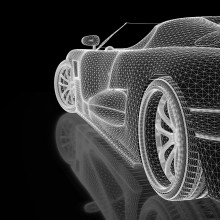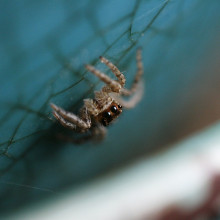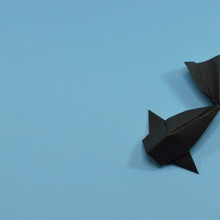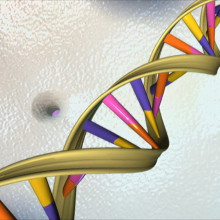Know When to Fold 'Em: Origami Science
This week we’re unraveling the science behind the ancient art of origami - paper folding - and how scientists are even doing it now with DNA. The new virus that’s appeared in China, news of the Australian bush fires, and why running a marathon can take years off the age of your arteries...
In this episode

New virus appears in China
AJ te Velthuis, Freya Jephcott, University of Cambridge
A new, previously-undocumented viral infection has broken out in China’s Wuhan City. So far, since early December when the first cases were picked up, about 60 people have developed the disease, some of them becoming severely unwell with respiratory symptoms. Scientists studying samples collected from patients showing signs of the infection have just announced that the new agent appears to be a member of a viral family called coronaviruses. Details of the new agent are still very sketchy. Chris Smith asked Cambridge University virologist AJ te Velthuis how this new infection could have appeared, and what might happen next, and then spoke with Freya Jephcott, also at the University of Cambridge. She models how disease outbreaks spread and was a consultant during the Ebola outbreaks in West Africa. She’s been looking at the latest updates from Wuhan City...
AJ - Going by previous outbreaks, these new viruses often emerge at animal markets, where different animals come together and viruses are able to spread from animal to animal, and then if humans visit those markets, those viruses can also spread to humans. In these cases you have domestic livestock which have been bred in high densities, and particularly those high densities allow the virus to spread very quickly and evolve and mutate more quickly as well.
Chris - Is this what we think happened with SARS back in 2003?
AJ - So in the case for SARS, we have a lot of evidence that allowed us to trace back where the SARS came from even from which market, and yeah, we were able to tell did it jump over from bats and from civet cats to humans at a particular market.
Chris - The mechanism then is you take an animal that we wouldn't normally spend much time rubbing up against like a bat, you put that in a market where there's an animal there next to it that's more similar to us than a bat is, and it can get into us via that other animal.
AJ - That's absolutely true. And this is also what we see in the case for avian influenza. It is quite hard for those viruses to spread between humans. But if you allow this virus to jump over to pigs and it can adapt, it has a much easier jump to humans.
Chris - So far, have they actually got any clues as to what this is?
AJ - At the moment they're ruling out avian influenza virus and SARS, but it could still be mutants of those particular viruses, and at present pretty much all cards are on the table.
Chris - So how do they gauge the threat and how do they minimise the risk?
AJ - To minimise the risk, the best strategy is to put people in quarantine, and monitor family members that the patients have been in contact with, and also to estimate if there is people to people, transmission. It is also important to notify the international community so airports can monitor people and see if someone is traveling with high fever.
Chris - So in terms of how we actually may manage outbreaks like this, what is now most likely happening in terms of investigating, probing the origin and following up both the people, and possibly the animals, that may have caused this?
AJ - So the markets have been closed down and they're being cleaned. People have been put in quarantine and samples have been taken and they're most likely sequenced now to figure out if there is a particular new virus present and whether we can relate to those sequences to known pathogens, and identify the virus better.
Chris - Are we comfortable that there isn't a threat to other people at this stage though?
AJ - Given that the virus is not spreading from human to human, the danger is better, simply limited. It is still okay to go to China. But you'ew strongly advised not to visit any animal markets right now.
Adam - Thanks to AJ te Velthuis, Freya, Jephcott is also at the University of Cambridge. She models how disease outbreaks spread and was a consultant during the Ebola outbreak in West Africa. She has been looking at the latest updates from Wu Han city.
Freya - Right now, it's unclear what's causing the current outbreak in Wu Han, from reports coming from the local officials, it sounds like they're fairly certain they're dealing with a virus, and it sounds like they've eliminated most, if not all of the common causes of viral pneumonia, as well as some of the rarer ones too like SARS, coronavirus and avian influenza. Since Wednesday, there have been some reports circulating that a novel previously unseen coronavirus was detected in one or more of the patients. In the past, coronaviruses like SARS and MERS have made the leap from animals into humans, and in the case of that 2002 SARS epidemic, it looks like that leap took place in a live animal market, much like the one implicated in the current Wu Han outbreak.
Even if it turns out that this is the case, there's still a lot more questions that need answering. What animal did it spill over from? Is this virus transmissible between people? Could it become transmissible between people once the virus has had a chance to adapt to its new human hosts? At present, there's still too little information available to ascertain what the true public health significance of this event is. Viruses are constantly spilling over from animal populations into human ones and only a very small proportion of these is capable of causing disease in humans. And an even smaller proportion of those is capable of causing a disease transmissible between people. That said, in an increasingly interconnected and densely populated world and with a respiratory illness, there is reason to be wary.

06:04 - Car brakes contribute to air pollution
Car brakes contribute to air pollution
Liza Selley, University of Cambridge
Air pollution is an increasingly large problem. According to the World Health Organisation, as many as one in eight deaths worldwide are linked to poor air quality. One kind of air pollution is called particulate matter, made up of any tiny particles in the air. But not all of it comes out of the exhausts of cars. Some of it comes from vehicle brake pads. The impact of that is the subject of new research in the journal Metallomics. Liza Selley joined Adam Murphy and Chris Smith to explain...
Liza - It's a little bit like when you sand wood with sandpaper, when the driver puts their foot on the pedal, two metallic components come together near the wheel. You have the brake disc and the brake pad, and when they come together it produces a lot of heat and a lot of friction and this wears away at the components and they release these metallic particles into the ait.
Adam - And why is that bad? What damage does that do to us?
Liza - These particles are really tiny, kind of like cigarette smoke. They're small enough to get deep inside the lung. They can cause a massive inflammatory response in the immune cells whose job it is to clear the lung of infection, and they can actually prevent those cells from taking up bacteria and killing it.
Chris - Do you know Liza, why the brake dust, or the metal particles stimulate the immune system and specifically the these macrophage cells and the immune system in this way?
Liza - Actually we've seen that other cells in the lung can be affected in a very similar way, but the metals are able to react with proteins, DNA, fats inside the cells. And this can affect the way that they function. And that goes on to have an effect on the cell's behavior.
Adam - And then what's the consequences of this short and longterm?
Liza - Short term, people get a lot more coughs, sore throats, asthma attacks. In the longterm, we worry a little bit about lung cancer and also development of infections like pneumonia. And that's just the lungs. People are looking at all sorts of different organs in the body.
Chris - And is it just the particles from brakes that could do this? What about vaping? Because that's tiny particles as well, isn't it?
Liza - Yeah, you're right. My colleagues at Kings College have looked at vaping and they've measured metals inside of it. That means it is a cause for concern.
Adam - Are there any recommendations that come off the back of this? Anything we can and should do to help?
Liza - So for you and I, everyday people, things we can do are try and reduce the amount of times we go out in the car. So I'm trying to do a weekly shop rather than go daily, which is quite difficult for me. But I'm trying my best. Things like sharing lifts, if you can, just trying to get your car off the road as much as possible.
Chris - I think that's good advice in all circumstances, isn't it Liza but, when one looks at the levels to which one is exposed in the air in a busy street, how does that compare with the levels of these things that you put onto your cells?
Liza - The air outside will be lower than what we're putting on our cells. But the reason we've got it this high is the nature of our experiments, we want to know why it's happening. So we need to see the response.
Chris - And that's kind of a worst case scenario, so it could be that actually we're not as much at risk, but if you walk down a very busy street in London at peak, you might be exposed potentially to the levels that you're testing.
Liza - Exactly.
Chris - And it's an indicator, excuse the car analogy, that actually there is a risk and as traffic densities rise we need to take more care.
Liza - Yeah, I agree.

10:19 - The science of a bushfire
The science of a bushfire
Guillermo Rein, Imperial College London
Since September 2019, Australia has been battling ferocious bushfires. Katie Haylor spoke with Guillermo Rein from Imperial College London about the crisis there...
Katie - Australia is in the grip of some of the worst bushfires the country has ever seen. Some have died, thousands have lost their homes, millions of acres of Bush had been burned and up to a billion animals may have perished. To find out how these fires work and what's driving them. I spoke with fire specialist Guillermo Rein from Imperial College London.
Guillermo - The situation right now in Australia is overly warm and there are winds, and these are the worst case scenario. It would be literally the fastest fire spread that has been observed in Australia.
Katie - Does the evidence suggest climate change is a factor here?
Guillermo - Unfortunately, we don't know enough to be certain about the role of climate change in the specific fires that are happening in Australia. It cannot be ruled out, if it does have an effect, it is through bringing unprecedented warm conditions to the forest, and making the forest pretty dry and windy.
Katie - I understand that these fires, when they get so very big, they end up making their own weather system.
Guillermo - Fires are self sustaining by the nature of the fuel burning, producing heat that heats up the next fuel layer, and then the fire continues, but there is a point where a forest fire can grow so large that it starts to alter the atmosphere around the fire. Smoke is hot and rises up, so when you have an incredible amount of smoke, it creates these very strong columns of currents that are going upwards that actually drag surrounding air upwards. Smoke has a complex composition. It has soot, it has hydrocarbons, but it also has abundant water.
So then this smoke, under some conditions creates its own clouds and then these actually move around. Also you need incredible amount of oxygen to feed these mega fires and the wind, goes towards the fire to provide the oxygen and the combination of the plume of smoke going upwards, and the sucking in of air creates its own wind, and these winds actually further accelerate the fire. These big clouds formed by the fire could actually produce lightning. Also, the smoke can be electrically charged so farther contributing to the electric charge of of the cloud. These could actually become additional ignition sources, although a fire itself, especially a mega fire, it has plenty of ignition opportunities. Unfortunately the flames itself, but also the embers that they produce and can travel hundreds of metres even kilometres by the wind and then it starts fires hundreds of meters away from the flaming front.
Katie - Given the scale of these mega fires, how on earth do you go about trying to tackle or manage this situation?
Guillermo - Mega fires cannot be suppressed. Firefighters have to take an offensive approach and just wait. While it is a mega fire, the best thing that they can do is move people away from the fire path. The difficulty is in making a good prediction of what could be the fire path. You could make an analogy with trying to predict the path of a hurricane.
Katie - What science is involved in actually calculating or predicting where the fire's going to go?
Guillermo - There is some models now that give it a try, but these tools, they are in their infancy, compared to the true desire of authorities to know accurately what the path of the fire is going to be. These tools just give a sense of direction and it's very important because you don't want to evacuate areas that don't need to be evacuated. We're talking about thousands of fire refugees and you definitely want to evacuate the ones where the fire is going to go, but the science is advancing as we speak.
Katie - How would you expect these mega fires in Australia to behave in the near future? Is it possible to predict?
Guillermo - We wish we could. It's not possible. Maybe if you ask me this question in 10 years time, I can give you better news. What we're seeing is more big fires. The term mega fire being in vogue way more often. So every single year we have fires in Australia, in Subsaharan Africa, Amazons, Mediterranean, California. But some years as is happening more recently, the fires are much larger and much more damaging, to people, property and environment. That is the trend, it is what is concerning fire scientists. We don't want to be waiting too long to start doing things differently. Australia in particular seems to be now in the need of doing something different.

15:22 - Marathon training improves heart health
Marathon training improves heart health
Charlotte Manisty, University College London and Barts Health
If one of your New Year’s resolutions was to take up running, apart from toned muscles and a narrower waistline, you might also be able to look forward to taking up to 4 years off the age of your blood vessels too! Chris spoke to Charlotte Manisty, a cardiologist at UCL and Barts Health about her recent work in the Journal of American College of Cardiology...
Charlotte - We were interested in whether participants who are planning on running the London marathon could reverse the effects of aging. We know that with age your blood vessels get stiffer and that leads to increased blood pressure but also leads to increased risk of dementia, stroke, heart failure, kidney problems, etc.
Chris - So who did you recruit and how did you measure them?
Charlotte - We took participants who'd been accepted through the ballot for the London marathon and we recruited anybody who had no preexisting history of cardiovascular problems and also who was relatively untrained. So participants that were exercising for less than two hours per week, embarking on a marathon for the first time. And we were looking at the effects of that training on their cardiovascular system.
Chris - Any particular age range or was it all comers?
Charlotte - We recruited participants of all ages, so the mean age across our study was 37 but there was quite a broad age range from 21 to 69 years and fairly reflective of the general population who are completing the London marathon.
Chris - And how did you work out how stiff their blood vessels were?
Charlotte - Well, we were interested in looking at the stiffness of the aorta, so the main blood vessel leading away from the heart, using MRI, so magnetic resonance imaging. And what we were interested in is looking at the speed of blood through the blood vessels and also looking at the distensibility or the elastance of the blood vessels so that we could look at whether exercise has a positive impact on the cardiovascular system.
Chris - So every time the heart beats the blood vessels stretch a bit, you're able to see that with an MRI scanner and that gives you a marker for how stretchy a person's aorta is. And you're asking "if I compare the measurements I make before they start training with what happens once they've successfully completed the marathon, is there a difference?" And what did you find? Does it make a difference?
Charlotte - Yeah. What we found was an improvement in the elastance when they train for the London marathon over that six month period. And that change actually equates to a four year reduction in vascular age. So it appears that you can actually reverse the stiffening effects that you get with aging by exercise training. What we also saw in participants was that they got a reduction in their blood pressure of about four millimeters of mercury. It's actually not far off equivalent of most first line blood pressure medications, and we know that that kind of difference in blood pressure, if sustained over a period of time, results in about a 10% reduction in stroke risk. So really the potential health benefits, if the changes that we see are sustained, is really quite significant.
Chris - And do the people critically have to keep up with the exercise regime to keep their four years of reversed blood vessel aging? Or if they then gave up after completing the marathon would their blood vessels remain four years younger than they should be?
Charlotte - Yeah. Now that's the crucial question and actually one that we haven't yet got the data to answer. We don't know whether the effects are sustained longterm, whether you continue to get incremental benefits if you increase your exercise, or if you sustain your exercise for longer periods of time. The other thing that we don't know and we would be interested in knowing is whether if you take patients who have got increased blood pressure at baseline, whether they get different effects. What our data suggests in healthy volunteers without blood pressure problems, is that it seems to be those that have greatest to gain, that have the biggest benefits. So if you are older, if you're male, if you're less fit, if you've got slightly increased blood pressure baseline, those are the patients that seem to derive the greatest benefit from the exercise training.
Chris - And do you know how it works?
Charlotte - It's a bit unclear. We know that some of this will be related to blood pressure, but what we can see is that there's actually changes beyond the differences in blood pressure. And this may be changes in the smooth muscle cells within the aorta. It may be due to neuro-hormonal effects. It's difficult to say. And we don't actually have the basic science data to support the mechanisms behind this. And certainly this is an area that's ripe for more research.
Chris - So is everyone in your research group now a runner? Are you doing the marathon?
Charlotte - Um, embarrassingly no! I have not done the marathon. I think people have definitely developed an awareness and certainly the first author on the paper, my PhD student is now running the marathon this year having not done previously. So certainly we are all more aware of it than we might otherwise have been.

Naked Reflections
Ed Kessler, Woolf Institute
The Naked Scientists are launching a new project with the Woolf Institute in Cambridge. It’s a new podcast called Naked Reflections, and Ed Kessler, the presenter, and director of the Woolf Institute, joined Chris Smith to tell him what to expect...
Ed - Hi Chris. Well Naked Reflections as you say is this collaboration between The Naked Scientists and the Woolf Institute and essentially we're doing a weekly panel discussion taking one of the latest scientific discoveries that you've been talking about here on The Naked Scientists, and thinking about it from a philosophical, ethical, religious perspective. Essentially, what does science and all this science stuff mean to the rest of us?
Chris - When you came to talk to us, the point that we made to each other really was that we tend to deliver science in quite a fast paced way. Here's a science story, ask some hard questions about it. Here's another story. And sometimes there's many, many different facets and viewpoints underpinning a story. And, and I guess that's what you're going to try and get under the skin of, isn't it? You'll take one of those stories and say, well let's pick this apart in a bit more depth.
Ed - Exactly. So for example, one of the episodes that's just gone up is on childhood. And we bring together a scientist in this case, Simon Baron Cohen, professor of psychiatry and psychology, with two non-scientists, Lindsay Burton, who studies children's literature and Julian Stanley, who's worked with teachers for many, many years. And we ask what's changed in our attitudes to childhood, how have they changed? How have children changed or not?
Chris - Tell us a bit about the Woolf Institute itself because you were the founder. What's its mission?
Ed - Essentially the Woolf Institute was founded to understand the relationship between religions and religion and society. And the premise is very simple. I believe that you understand yourself better when you encounter somebody else. And that's true of identity and it's true of religions, it's true of society. And what I'm excited about with this podcast, is we're bringing together, we're encountering these different disciplines and just thinking about what is going on, questions of authority. Here, you Chris an authority on science and myself an authority on interfaith dialogue. But what do we do when people don't take our authority seriously? On what grounds do we debate these things on?
Chris - Many people may say though, and in fact people do say to me, religion and science are often uneasy bedfellows, so why are you making a program about science?
Ed - Well, in a way I'm unpacking what's going on in science. I'd like to think that you scientists would tell us how things work. I'm interested in the meaning of all of this for the rest of us, beyond the science community, because if we can extend it then the reach, not just of The Naked Scientists, but also the Woolf Institute will be far greater than it is at the moment.
Chris - And what's on your radar? Have you got any ideas upfront already as to things that you're going to be addressing next that are priority areas?
Ed - Well, one of the areas we're looking at, it may sound not a priority, is music. Are we touched by God as it were when we listen to music? But it's also governed by maths, the study of genetics, that modification of genetics. I mean these are all really important issues of the moment and between the Woolf Institute and The Naked Scientists, I think there's something there that all of us will benefit from.
Chris - And just lastly, how will you know if you've succeeded?
Ed - Ah, bring me back in six months and let's see what emails you've had, Chris, and what messages I've had. Let's see what people have to say.
Chris - It's a challenge accepted Ed. We'll get you back in six months. You could tell us how you're getting on. Now, if you want to give Naked Reflections a listen, you can find all the details about how you can subscribe. The initial episodes there are, I think eight of them, nine now, are on nakedscientists.com/reflections. And it tells you how you can subscribe and it's available via all the main podcasting channels. It's completely free. And give it a listen, these half hour conversations with a range of different perspectives. Absolutely fascinating.

Mailbox: Real life Spider-man
On Facebook we received a question from Andre Peter F. He wanted to know if you can combine human and and spider DNA. Adam Murphy asked Chris Smith if that could be done...
Chris - The answer is, well, he could, but it might not actually be useful. The reason you can move genes from one organism like a spider to another organism like a human, is because the genetic code is universal. Because we all owe our existence to a form of life that evolved billions of years ago and gave rise to all of the life on Earth and it used DNA, the genetic code it used to store its genetic information has been passed into every single one of its descendants, and that means that the program and the code that's used to encode information in DNA means the same to a spider cell as it does to a human cell with a few minor differences. Even to a fungal cell or a bacterial cell. So we can take a gene from one organism and put it into another organism and the cell would understand it. Whether it would actually make useful things in that, it might not do anything. But this certainly can work in principle. And the best example of this is that years ago scientists discovered, and in fact someone got the Nobel prize for, the discovery of a protein called GFP, green fluorescent protein. This comes from jellyfish. If you take that protein out of a jellyfish and you add it to say a mouse cell, that mouse cell will read the gene, produce green fluorescent protein, and you can make mouse cells that glow bright green. In fact, if you put that into a mouse egg and make a mouse baby from that egg, you can end up with a whole mouse that will glow green under the right circumstances. So the answer is you could do this with spider DNA, but you couldn't make a Spiderman because the spider and the human are thankfully really quite different things.

27:06 - The mathematics of origami
The mathematics of origami
Robert Lang
Origami is paper folding. And paper wasn’t invented until about 2000 years ago, and the first documents about the art of origami date from the 1700s, so it’s a relatively young art, but one that Adam Murphy was keen to master, with the help of origami artist Robert Lang...
Adam - Okay. So straightforward so far. Corner to corner, fold side to side. And then it... then it's just... some kind of magic apparently that... nope. Aargh!
Adam - Origami. Paper folding. It's a new hobby I'm trying to learn. And when you want to learn something new, you go to an expert. For origami, that's Robert Lang. Robert used to work in laser physics, developing complex mathematical models that would predict how lasers would behave in different situations. And one day he realised the approach you took to physics might also work for his hobby.
Robert - Origami felt like it was amenable to that sort of approach, that there were simple mathematical laws that described what you could and couldn't do in the world of origami. And so if I learn those mathematical laws, if I could put them in the language in mathematics, then I could use the tools of math to accomplish the goals that I wanted to accomplish in the world of origami. And that actually worked out quite well. So first off, the math helped me design origami figures that I really wanted to design and had not been able to figure out a way to design; but also the math that describes origami for the design of artwork, also works to describe things that fold that might have technological applications - deployable structures and the like. And then the math itself is interesting. So sort of all three of those things led to an expansion of my world of origami, expanding the art, and leading to applying folding and origami to technological applications; and also just leading to exploring the mathematics of folding itself.
Adam - It's been around for centuries growing slowly, but that growth has been getting faster and faster. At the time, origami only went so far. Robert was looking to make more detailed animals, things like spiders that have all their legs, or a deer with its complex antlers.
Robert - The goal was to create realistic representations of shapes that had appendages; arms, legs, wings, antennae, and the like. And those were considered very, very challenging to do in origami. In fact, there are books from the 1970s that say, "to do a grasshopper you would need to use two squares of paper." And people just didn't know how to get lots of features from a single sheet of paper. And it turned out that there was some very elegant mathematics that told how to get any number of arms and legs and wings and antennae. You could just follow a mathematical procedure that would give you the fold pattern, that would fold into a shape, that was guaranteed to have exactly the right number of arms and legs and so forth, at exactly the right length and connected in exactly the way they specified.
Adam - So by applying maths to origami, folding paper took a quantum leap forward and a whole range of new things could be made. But maths sometimes feels like it's just equations on a piece of paper. How does it work when you want to fold that paper into a new shape?
Robert - A flap, you know, an arm or a leg, can be represented by a circle. That circle represents the minimum amount of paper needed to produce that flap. And the problem of getting all of your flaps from a single square of paper boils down to fitting all of those circles inside your square in such a way that they don't overlap. That's like stacking a bunch of balls in a square box. You could figure that out. And then we can follow a second set of rules that creates the creases, that involves drawing lines between the centres of touching circles. And by following these step by step processes, we can construct the pattern of all the folds you need to make that shape. It may seem mysterious if you just hear the rules; pack circles, and then construct lines according to these rules that don't seem to have anything to do with folding, and then once you get your finished drawn pattern, you can fold on all those lines and magically it will have the right shape. It may seem mysterious, but math tells us it's not mysterious. I mean, mathematics establishes exactly why those particular rules give you the resulting shape that you're after.

32:39 - Your brain on origami
Your brain on origami
Duncan Astle, University of Cambridge
What goes on in your brain when you learn something like origami? Duncan Astle is at the department of neuroscience at Cambridge University, and he joined Chris Smith and Adam Murphy to explain all about the brain...
Duncan - Well, first thing to say is that when you use the word memory, there's lots of different things that you could be meaning. So you might mean, you know, where did I park the car earlier? That's a type of memory. But this is a very different type of memory: it's implicit memory. And we know that it's really quite separate from explicit memory, and that's because even people who have amnesia - often due to brain damage, so they've lost the ability to lay down new explicit memories - they can still learn really quite complex skills, something like origami.
Chris - So if I took someone who had no ability to make new memories, and I asked them, "what have you just done," they would have no idea; but they would have some kind of latent motor memory of folding paper to make something?
Duncan - Exactly. So there's some really nice studies showing that each time the patient comes back in for their next training session, they show no explicit memory of having done any previous training sessions, but their performance on the tasks shows that they are getting gradually better. Just as you would expect with someone who didn't have amnesia.
Chris - How is the brain storing a memory at all? Whether it's actually something which is, where I parked the car, or a new sequence of motor movements to fold paper.
Duncan - So behind your eyes, buried quite deep, is a structure called the hippocampus, and there's lots of brain structures around it. And we know that that structure is really important for explicit memory. So if it's damaged, that might well impair your ability to lay down new explicit memories. But we know that that's not necessary for learning higher order skills like origami. And so if you think of the brain, think of Adam's brain, it contains probably about a hundred billion neurons - or brain cells - give or take. And they're specialised for different things. So there'll be some that are specialised for planning, for attention, for rotating mental objects, and for fine motor skills. And if you can train someone over a long time on a complex task like origami, then the brain starts to join up those brain cells in a stronger way.
Adam - Now I know for most of the models I've been practicing with, I still need the instructions in front of me, but something like the Japanese crane I can just do without having to think about it. It's like my hands just do it. What's going on there? Like with muscle memory?
Duncan - If you think about where your ears are, and you were to draw a line between those and the top of your head, you would have drawn a line across what's called the motor strip. And so that's the part of the brain that's really important for fine motor control. So for instance, all of the brain cells that control your digits, your fingers, can be found in there. But they're connected to areas just in front of them, called premotor cortex, and to lots of areas in the parietal lobes just behind them, which are really important for thinking about spatial relationships. And we know that if you train someone on something like origami, then as they get better at it, those areas become denser, so they sprout new synapses or new joints to other brain cells; and they become better connected, so you get boosts in white matter, which is the insulation around the cables of the brain. And so essentially as you become more of a master at origami, those areas become more hardwired together and so they're better able to communicate information.
Adam - Okay, so now I can fold things like paper, birds, and turtles. Is that going to help me elsewhere? Will I become a better guitar player because I know how to fold a bird?
Duncan - The million dollar question. So there is now an emerging science of brain training. It's still in its early phases, but what we and some others have shown is that over the course of the training, you can gradually alter the connections between these different parts of the brain that are needed for the task; and that that improvement will generalise to other things, but often not very far. So for instance, it might generalise from making a crane to making a turtle, but it might not generalise to playing the guitar. There is a study out there showing that kids who've got maths problems, for example, they do respond positively to an origami intervention. But as with many of the studies in this area, the devil's in the detail, you know, there's no control group in this, and the group is very small for example.
Chris - I read a study, I think it was in Nature Neuroscience a while back, and it was looking at people who were being shown people throwing a basketball at a basket. And the way they did the study was they asked the general public and basketball coaches to look at shots where the ball was shown leaving the hand of the thrower, and they were asked, "did it go in?" And they also had a third group they studied that were pro basketballers. They looked at the small muscles in the hand, the electrical activity going on. And what they found is that the basketball coaches, despite being very good at basketball, were no better than the general public at making these predictions. "Will the ball go in?" But the pros were really, really good at doing it. But when they looked at how they were doing it, there was activity in the muscles in the hand that they would have thrown with. And it was almost like they were mapping onto their own brain what they were looking at, and pretending they were the thrower on the basketball court. And that was enabling them to make these very accurate predictions about whether or not that ball would go in.
Duncan - Yeah. So the area of premotor cortex we know is about sort of sequencing complex movements, and it's highly overlapping with areas involving things like mental imagery. And so it stands to reason that the better able you are to sync that area with the actual motor cortex... the two things kind of go hand in hand. So for instance, when you're learning to do a complex sport like tennis or rowing, often your coach will make you watch people do it really, really well. And actually that can have a very beneficial effect on your ability to do it because it's strengthening those connections.

38:40 - Finding functions for paper folding
Finding functions for paper folding
Larry Howell, Brigham Young University
There's science behind origami, but is there any origami behind science. Larry Howell is at Brigham Young University in Utah, and he spoke with Adam Murphy about the work his group is doing, finding functions for folding...
Larry - So you can think of origami, you know, starts out in a flat sheet, so it's very compact, but then as it folds up sometimes it's very complex shapes. So what that does is it gives us the ability to do things where we want a device that's very compact in one state, but then can expand out and do something complex in another state. So two examples of that are getting, say, solar panels or large antennas into space. If I want a huge solar panel in space, I can't just launch it there, I need it to be very compact for launch, and once it gets into space to deploy that. And so that's some of our early work with NASA, was to look at different options of how to use these origami principles to do things to launch into space. Another one is to do surgical instruments. So you would prefer to have a very small incision when you go into surgery, because that helps to decrease the recovery time and the trauma. And so now if we could have a small incision to go into the body for surgery, but then have it expand out and do complex tasks inside the body, then that is just a really good idea that helps patients in a lot of ways. The less obvious couple of applications that we've done: one was a bulletproof ballistic barrier. So it's kind of weird to think of, "Hey, I can make origami bulletproof." In this case we're using Kevlar, which is a bullet-resistant material, but then finding ways to fold that up; and so now you have a bulletproof barrier that can be very compact to be stowed when it's not needed. So let's suppose it's a police officer and they're storing this in their boot, and come out and need this ballistic barrier because there's something going on; and now they can pull that out and deploy it.
Adam - What kinds of things do you have to consider when you're trying to make something that isn't paper, foldable?
Larry - Paper is a very unique type of material. When you crease it, it delaminates; which means that the microscopic structure, what's going on inside of the paper, all kind of breaks apart. And what happens is it makes the paper that much more flexible at that point. So we've all experienced the thing where we crease a piece of paper and unfold it, and it will unfold right there at that same place where we put the crease. But now, do an experiment and go to your kitchen and get some aluminium foil - that you might use for cooking or something - and crease it like you do paper, and then unfold it flat again. And you'll find that it does not unfold at that crease. You have actually made that material stronger at the crease by doing something we call work hardening. And so other materials do not fold, and crease, and then unfold like paper. And so you have to find other ways to do that. What we've done is defined some creative ways of using cuts and other things, and we call them surrogate folds or surrogate creases, something to replace a paper crease.
Adam - And just lastly, what do you reckon the future is for this field? Where do you think it could go?
Larry - What's exciting about this is this is really just the beginning. As we discover these fundamental concepts of what makes it all work, how we can translate it into materials other than paper, we're finding very stunning applications. But there are so many things that we've just not conceived of, and as other people understand what they can do with this, there's going to be just continued explosion of applications, new uses of origami, and it's exciting to be a part of.

DNA Origami
Ulrich Keyser, University of Cambridge
It’s not just technology that folds in special ways, biology does too, including DNA. But how does DNA fold, and what can you do with that? Ulrich Keyser is from the Cavendish lab in Cambridge and he joined Chris Smith…
Ulrich- The reason why we want to do this, because structure and function are closely related and especially on small length scales, you really need to control the position of every atom in a molecule to make a certain function and DNA we understand so well because since Watson and Crick found out that you have a double helix, you can actually manipulate this material now in that way that you can really build on molecular length scale whatever you want.
Chris - So it's not for its ability to carry information in a genetic way that you're using DNA, you're using it because we understand very well how it effectively organizes itself in three dimensional space because of its chemistry.
Ulrich - Exactly. Because we understand exactly how the information carrying works, we can program a certain information and this will then fold into a three dimensional shape that we give. So it's like taking Lego bricks where you just take whatever, green, red and blue one and then put them a little bag, shake them, and then you open the bag, the green and the red and the blue one are all connected in the right way and then you can make this into complex three dimensional shapes.
Chris - So when you want to do this, do you literally have a computer program that says, "that's the shape I want to make"? And then you synthesize a string of DNA letters all linked together that just makes you the lump of DNA and then as you do that, it's assembling itself because of the chemistry of DNA into the structure you thought?
Ulrich - It's so easy, as you just said. So we have a shape in mind, for instance, a barrel or a ring and then we put into a computer program and the computer program calculates the lowest energy state for these kinds of systems. And then it spits out normally 200 small sequences or DNA pieces that we have to order from a company. And it's now all automated almost, we just sent an email to the company and a week later you get it in the post. You mix everything together, heat it up, cool it down and then you have billions of these structures in your teacup. Now with advancements in chemistry, you can even put different chemical groups in different places. So for instance, nature uses these kind of molecules for capturing light and we can do the same or we can actually build small mimics of proteins that actually do the functions in cells. We can now build them from DNA molecules that we forced into these kinds of shapes.
Chris - Well, I'm glad you brought that up because I was going to ask a lot of people listening to this probably thinking, it sounds like you're having a lot of fun doing this, but what's the point? But this means that you've potentially got the ability to exactly control where things are in three dimensional space, at the atomic level, so you can build tiny, tiny, tiny things with enormous precision.
Ulrich - Exactly. So what we can actually do, we can make these DNA molecules to drill a hole into a cell. What we are interested in at the moment is to see how we can actually build these kind of ion channels that control flow through a cell membrane from DNA.
Chris - Because the body does that by using proteins, doesn't it? That's another polymer made by linking together molecules called amino acids. And the body builds those up and they form and assemble into these big complicated three dimensional structures. So you're saying, I'm going to use DNA to make a replica of that, which it might be made of a slightly different material, but it's going to look the same and it sure as hell is gonna work the same. It's kind of like the nanoscale equivalent of a hip replacement where instead of you putting an artificial hip in, which works like a hip joint, but it's obviously not made of the same stuff, you're doing a similar sort of thing.
Ulrich - Exactly. And the big advantage there is that DNA is of course inherently biocompatible. So we hope that with this kind of approach, we can really make biocompatible medicine that can be tailored to certain patients because you have the flexibility in building whatever you want for a certain disease or certain person.
Chris - Oh, neat. Because we know a lot of diseases, for instance heart abnormal rhythms and so on, are because some of the channels in the heart that convey electricity through the muscle cells are the wrong shape. So you could potentially then knock up a new structure out of DNA and put that into the heart cells to stabilize a heart rhythm?
Ulrich - Fundamentally what you can do is you can take these ion channels made from DNA, add them to muscle cells, also to neurons actually, and then see how they change their behaviour.
Chris - Are we very far away from actually realizing tractable, tangible examples of this in industry and in the real world?
Ulrich - Prediction of this kind of thing is very difficult. But I think that personalised medicine will come a long way in the coming years and I'm pretty sure that some of this technology will end up pretty soon in patients. I mean, pretty soon means 10 years.

49:56 - QotW: Why does phone signal vary so much?
QotW: Why does phone signal vary so much?
Katie Haylor asked signal expert Ramsey Faragher from Focal Point Positioning and Cambridge University to dial up an answer to Derek’s question about wandering mobile phone bars...
Katie - When you dial up your buddy, a signal is being sent from the transmitter in your phone to a cell phone mast and from here it travels to the receiver on your friend's phone, facilitating communication. We asked signal expert Ramsey Faragher from Focal Point Positioning and Cambridge University to dial up an answer about those wandering mobile phone signal bars.
Ramsey - Signal fluctuations can typically be caused by two main effects. The first one is objects moving in and out of the line of sight between the phone and the radio tower, things like vehicles on the road outside. But if the signal is fluctuating quite rapidly, then the second effect is likely to be dominating here and that's called multipath interference. Because radio signals don't just pass completely through non-metallic objects, some of the energy is actually reflected as well, in a typical room that can be lots of copies of the same signal bouncing around. Often there's just one dominant loud signal still, but in Derek's case it's possible that in his room there is no main dominant signal and all of these different copies of the same signal are interfering with each other.
Katie - Just like water waves, radio waves have peaks and troughs. And if the signals come together at Derek's phone all nicely lined up, peak to peak, then the signal will actually boost a little. But if they align peak to trough, they can cancel each other out and the signal power can drop to next to nothing.
Ramsey - Signals can sometimes take quite complicated paths to get deep inside a building and it could be the movements of objects that are dozens of metres away from Derek that are actually causing these fluctuations he's seeing. The wavelength of radio signals used by mobile phones is about 20 centimetres. And so people and objects and vehicles that are moving around even just a few centimetres in the area around Derek, they can be what are causing these fluctuations he's seeing, as all of the radio signals that bounce off these objects vary in their path lengths by a few centimeters and sometimes boost and sometimes cancel each other out. So my top tip for Derek, if he's struggling to get his messages out, with his fluctuating signal strength, is to gently shake his phone. Just a few centimeters is enough and it will allow him to average through the multipath interference and it will increase his chances of getting that critical tweet out of the door.
Katie - Thank you Ramsey for beaming us that answer. Next time we're getting physical with this fertility question from Jure.
Jure - Hello Naked Scientists, I would like to know why a woman's body doesn't reject sperm as a foreign object.










Comments
Add a comment